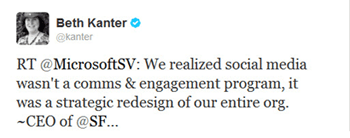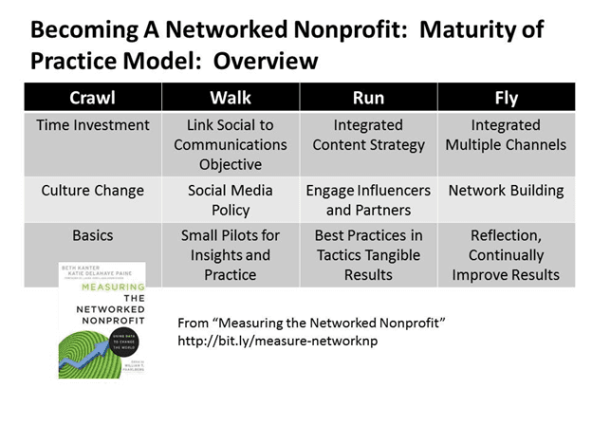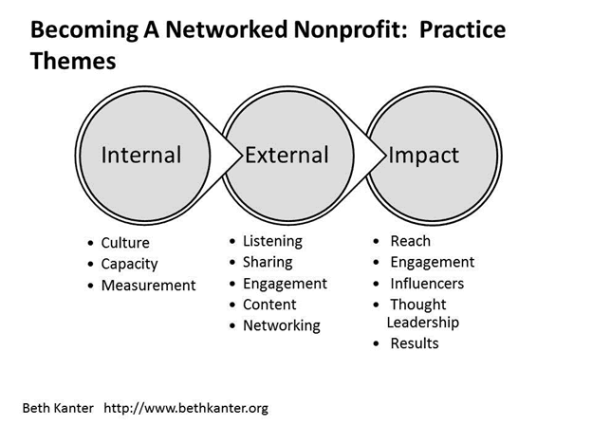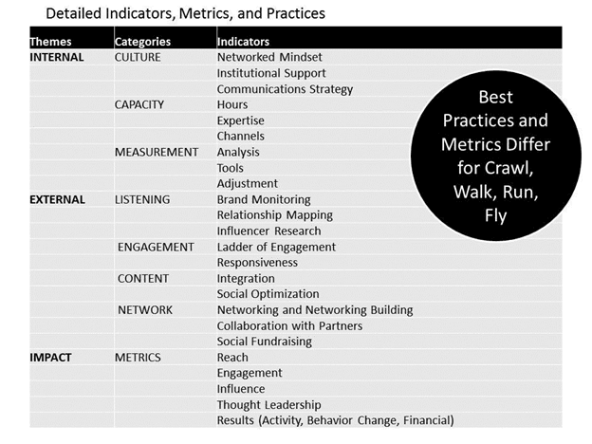
The environment in which nonprofits are doing their social change work has changed dramatically over the past five years. It’s more complex, online networks are central to our lives and work, and stakeholders want more involvement. Seeing tangible results from your organization’s social change efforts now requires two things to be successful: leading with a network mindset, and using measurement and learning to continuously improve. It is just not about using the tools—having a Facebook brand presence or tweeting as the CEO of your organization—it is a total redesign of your organization.
A network mindset exercises leadership through active participation, openness, decentralized decision-making, and collective action. It means operating with an awareness of the networks the organization is embedded in, and listening to and cultivating these networks to achieve impact. It means sharing by default and communicating through a network model, rather than a broadcast model—finding where the conversations are happening and taking part. It isn’t always easy or fast to do, as CEO of San Francisco Goodwill Debbie Alvarez-Rodriguez shared in a recent presentation about becoming a networked nonprofit.
Getting comfortable with social media and showing a little bit of themselves is the first step for leaders to make this leap to a networked professional. But as Debbie Alvarez-Rodriguez and other nonprofit leaders have discovered, social media isn’t just an engagement platform; it requires that organizations redesign how they work. Having a multi-channel marketing strategy, and competence and comfort using social and mobile tools is important, but organizations also need to incorporate networked practices, including having leaders leverage both their professional and organizational networks.
Success happens for nonprofits if they take small, incremental, and strategic steps. In my forthcoming book, Measuring the Networked Nonprofit, co-authored with KD Paine, we introduce a framework called “Crawl, Walk, Run, Fly” to help nonprofits figure out what incremental steps they need to take to get to the next level of networked nonprofit practice. It is designed to help them understand and measure the nature of the change process as they move through it. The model below indicates areas where organizations should focus time and learning to move to the next stage.

Are you enjoying this article? Read more like this, plus SSIR's full archive of content, when you subscribe.
The Crawl Stage
Crawlers are not using social media consistently or measurement processes; they also lack a robust communications strategy. Crawlers can be small or large nonprofits that have all the basics in place, but they either lack a social culture or resist transforming from a command-and-control style to a more networked mindset. These nonprofits need to develop a strategy. Even with a communications strategy in place, some organizations may face challenges to adopting a networked way of working. If so, they should start with a discussion of the organizational issues, followed by codifying the rules in a social media policy. They should also anticipate learning and benefiting from inspiring stories from peers.
The Walk Stage
Nonprofits in this stage are using several social media channels consistently, but may not be strategic or fully embracing best practices—maybe they don’t engage with users, or they only share content and messaging produced by their own organization. These nonprofits need to create a social media strategy to support short- and long-term objectives, such policy change or increasing public engagement on an issue. Walkers internalize listening, and use the data they collect to improve engagement and some content best practices.
These organizations implement small, low-risk projects that collect stories, learning, and metrics to help leadership better understand the value, benefits, and costs. Walkers should focus on one or two social media tools, going deep on tactics and generating tangible results and learning. They must identify low-cost ways to build capacity internally, such as integrating social media responsibilities into existing staff jobs. Capacity is built with support from leadership and a social media policy formalizes the value and vision.

The Run Stage
Runners use more than two social media channels as part of an integrated strategy, identifying key result areas and metrics that drive everything they do. They have a formal ladder of engagement that illustrates how supporters move from just hearing about your organization to actively engaging, volunteering, or donating to your organization. This is used to guide strategy and measurement. They visualize their networks and measure relationships. These organizations practice basic measurement religiously and use data to make decisions about social media best practices.
In these organizations, a single department does not guard social media, and staff are comfortable working transparently and with people outside the organization. The board is also using social media as part of its governance role.
To build internal capacity, runners invest in a community manager whose job it is to build relationships with people on social media or emerging platforms. These organizations know how to create great content, and use an editorial calendar to coordinate and curate content across channels. They are routinely tracking the performance of their content strategy and adjust based on measurement.
The Fly Stage
These organizations have institutionalized everything in the running stage. Flyers embrace failure and success alike, and learn from both. Flyers are part of a vibrant network of people and organizations all focused on social change. They use sophisticated measurement techniques, tools, and processes.
Do you lead your nonprofit with a network mindset? Where is your organization in the shift to being a networked nonprofit? What do you need to get to the next level?

I am looking forward to discussion on networked practice at SSIR’s upcoming Nonprofit Management Institute.
Support SSIR’s coverage of cross-sector solutions to global challenges.
Help us further the reach of innovative ideas. Donate today.
Read more stories by Beth Kanter.

